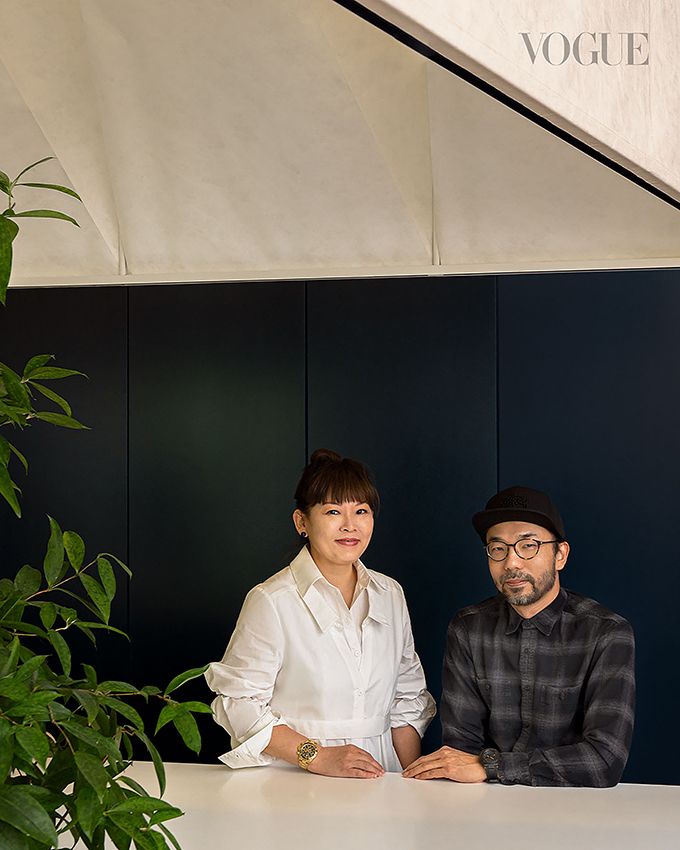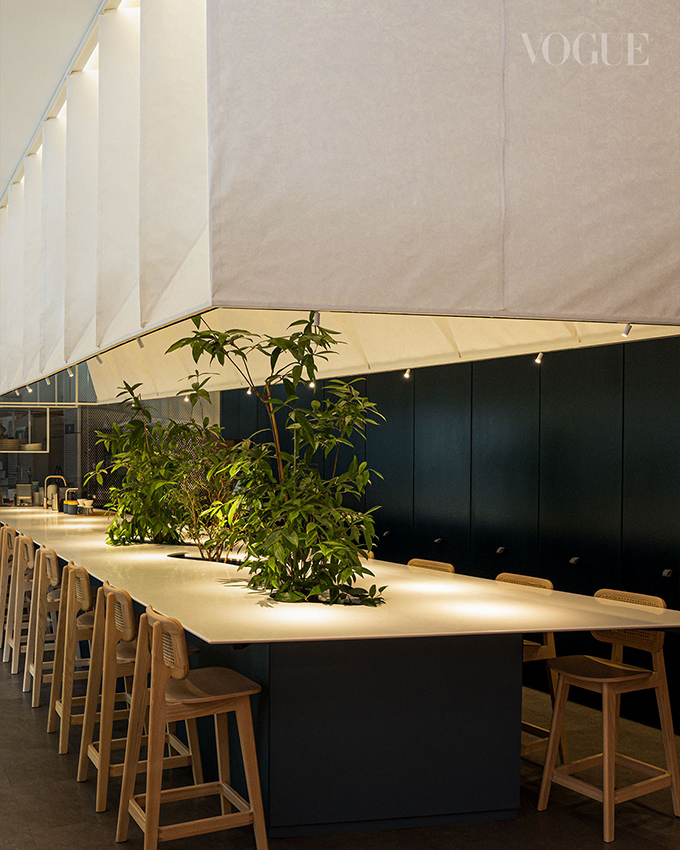Kenneth Seah only wears black and his wife Delphine Liau has the receipts to prove it. She pages through a portfolio of cut-out news articles, reviews and profiles, a veritable archive of the last decade of their lives together. The compelling historical evidence that Liau has collated suggests that their dessert studio, Kki (pronounced ‘cakey’), may have changed location thrice and menu countless times, but her husband’s wardrobe abides.
Their nine-year-old daughter, Shannon, knows all of this already—she was there for most of it. Now, she jumps up and down, chanting at her mother: “Next page! Next page! Next page!” She knows every photo; she doesn’t have time for this. She’s going to be a professional ballerina one day. Her preferred Kki dessert used to be “J”, a black sesame and yuzu concoction, but now it’s the chestnut and cassis Marronnier. Who knows? If her father comes up with a new one next week, that could be her new favourite.
Shannon’s seen it all. Her little sister, Sasha, was born two months after Seah and Liau had to close Kki for the second time in 2016. All Sasha’s ever known of Kki has been at the unmarked brick-and-mortar studio tucked beside Raffles Hotel, which opened in July 2020. But both daughters have grown up alongside the brand, whether Kki has been on hiatus or in full operation, as have the hundreds of customers that Seah and Liau consider their regulars, who have gone “from dating to getting married to now bringing their own kids”, Seah explains.

Kki’s indulgent creations are grounded in a fundamental idea of quality over quantity. Slow living values and a playful attitude towards what’s not shown inform the business mindset that Liau and Seah have been honing since 2009. They don’t do takeaways or queues. There are no dessert photos on their website. In the shop, there is poor phone reception and a strict no-laptop policy. You respect the craft, which means you don’t request alterations to your cake just because you don’t like mint or mango. Despite this, Kki doesn’t deal in absolutes, but in the common understanding they share with their customers: if you try your best to respect their rules, they’ll attempt to give you the greatest dessert experience of your life.
That said, Liau loves it when a customer comes in in a bad mood because that gives them a chance to try and make them feel a little bit better with the power of sweets. Work-stressed Singaporeans will come in, put away their gadgets for an hour and enjoy a cake or plated dessert that was crafted specifically for them by Seah that morning. Maybe they’ll read a book, or talk quietly to Liau or one another, but the aim is to have them leave “feeling satisfied”, she says.
Seah agrees with her. The couple echo each other a lot, as a matter of fact. When one trails off, the other will pick up the thought and run with it in a new direction. Their speech patterns and movements around the small, 24-seat studio naturally ebb and flow in tandem with one another. This is the rhythm you pick up after you’ve been married for 13 years and business partners for 10.
“We didn’t want the dining and the kitchen to be separated. The customers get to see you, like you’re cooking at home”
Seah makes the cakes, Liau sources hard-to-find ingredients and collaborators. He’s more hands-on with the kids, she runs the business side of things. He’s the more fashionable one—when her mother says this, Shannon makes a noise of disbelief. The point is, they’re artistic and practical in turn, which also means they fight a lot. “Almost every day. Good times or bad times,” Liau says, grinning. Times are tough in the Singaporean food and beverage world; they always have been. Rent hikes, stiff competition and staff shortages have mortally wounded many of their contemporaries over the years, and Liau and Seah often have different survival plans. “But we compromise.”
This partnership, alongside their loyal following, is what has led them to Seah Street. “We’re taking the street back,” Seah notes wryly. He’s a descendant of Seah Song Seah, one of the famous brothers for whom the street is named. The space is airy but intimate, with allowances for Seah and Liau’s love for the middle ground. The one long dining table for customers punches directly back into the kitchen. “We didn’t want the dining and the kitchen to be separated,” Seah explains. “The customers get to see you, like you’re cooking at home.”

That feeling of home is also due to the fact that at Kki, no matter where you’re from, there will be some element you’ll find familiar and comforting. From the beginning, the studio has plucked from Japanese aesthetics, French culinary techniques and Singaporean history. This intermingling of cultures sprouted naturally from that essential Kki middle ground. “I think the era that we were born in, we’ve seen the old and the new, and we love the in-between,” Seah explains. “The transition, I think.”
When it came to putting the new Kki space together, though, Seah and Liau only knew what they didn’t want, separation, but also things like pendant lights and cake displays. They told their designer, Pan Yi Cheng of Produce, this. He came up with the communal table, which he modelled after a kabuki stage and the tables of 18th-century European coffee houses. The fins jutting from the ceiling are reminiscent of a tall ship or Maori wharenui. It was Pann Lim of creative agency Kinetic who revealed the ‘uplifting’ arrow hidden in the brand’s logo when he tipped ‘Kki’ onto its side. Then, of course, the customers came, 300 regulars fully booking out the studio for its first two weekends—none too shabby for a dining space that could hold, at that time, 10 people an hour.
“After the day-to-day fighting fires, if your vision is clear, and your purpose, and where you’re heading—that’s what keeps us going”
Historically, community barn raisings like these often occurred after a disaster. Kki’s calamity was its time at the School of the Arts (SOTA). After a doubling of their rent forced Seah and Liau out of their first storefront in Ann Siang Hill, where they had been happily sandwiched amongst other indie institutions like BooksActually, The Little Dröm Store and Woods in the Books, they had thought opening shop at an art school would be the perfect way to thrive. “I was hoping that students would come. Not just to hang out, but maybe, say, you want to play music, explore, display your art, whatever,” Liau explains. They struggled for a little over two years as the students’ punishing hours kept them from little else besides ducking in and out of Subway across the street. Liau knew every student who came in regularly. “That’s how little there were.” They were a balm, buying a tea and chatting to Seah and Liau to remedy their own scholastic stresses, but they weren’t enough.
“SOTA just killed us,” Seah says, as Liau nods gravely. “Yes, SOTA killed us. We lost everything.”
They were closed for three and a half years. Seah consulted for F&B brands, and Liau gave birth to Sasha and went back to event management. Liau always kept one ear to the ground, though. “We wanted to come back,” she says. “We knew that we wanted to come back. We just needed the money first.” Any investor who wanted in—and there were several—had to first understand that Kki was never going to compromise its values or sell out. There would be no talk of franchising or working to a schedule of anyone’s beside their own. That made most of them baulk and vanish.
Then, one Thursday, Liau got a text from a former regular customer, asking when Kki would return. Liau explained the financial situation. The once and future customer texted back: “How much do you need?” On Friday, Liau met up with the woman and told her to think about it—Kki was never going to be a cash cow, after all. On Saturday, Liau received another text: “Let’s go.”
“I said we sowed the seed, but they are the ones who watered the plants,” Liau says proudly of Kki’s customers. “If we could go out as a Singapore brand, they should be proud of it because they were part of our journey.”

Seah is a little more droll, saying: “She wanted her cake back.” Or some version of it—after all, Kki’s menu is continually in flux. Passionfruit and coconut are replaced by grapefruit and lychee, and the white chocolate Antoinette is supplanted by the dark chocolate Nero, though old favourites will always reappear eventually. Seah still revises and improves on recipes he created a decade ago. “And it should be that way because customers are travelling here, spending time, paying money for it,” he explains. “It’s got to be life-changing.”
Seah and Liau have a life that revolves around cakes. When Seah worked in optical manufacturing in the early noughties, he used international trade shows primarily as an excuse to sample cakes from far-flung places. When they visit Japan on holiday, Liau says, she can’t tell you where a good place to get sushi might be. “But cakes—ask me which cake shop to visit, we have a whole list.”
They use cultures abroad to try and inspire the one back home. There is no style of service nor a sweet export that truly defines Singapore, Liau explains. She speaks disdainfully of the Merlion chocolates that populate souvenir shops here. Defining that culture more clearly for themselves, their customers and the next generation is what’s next for Kki.
“I think once you have a purpose and a vision, it makes it a bit easier,” Seah says. “After the day- to-day fighting fires, if your vision is clear, and your purpose, and where you’re heading—that’s what keeps us going.”
It may take a while to get there, but they don’t mind. “To the kids, I say, ‘You don’t have to rush,’” Liau says. It’s not clear whether she means her own children or the next generation of Singaporeans writ large—perhaps it’s both. “Kki’s not about rushing.”
With that, she and her daughter amble out the door; Shannon has ballet class soon. Seah sees them off, then turns back to the task at hand—intricately placing dozens of chocolate shards around a domed chocolate cake, painstakingly building an ornate thistle of a dessert. Shannon’s class is all the way over on Queen Street, and Seah and Liau have ardent customers patiently waiting. But all of them will get to where they’re going, right on time.
Deputy Editor: Amelia Chia
Art Director: Henry Thomas Lloyd
Fashion Director: Desmond Lim
Photographer: Hosanna Swee
Hair and Makeup: Greg’O using Estée Lauder
Photographer’s assistant: Darrel Neo





